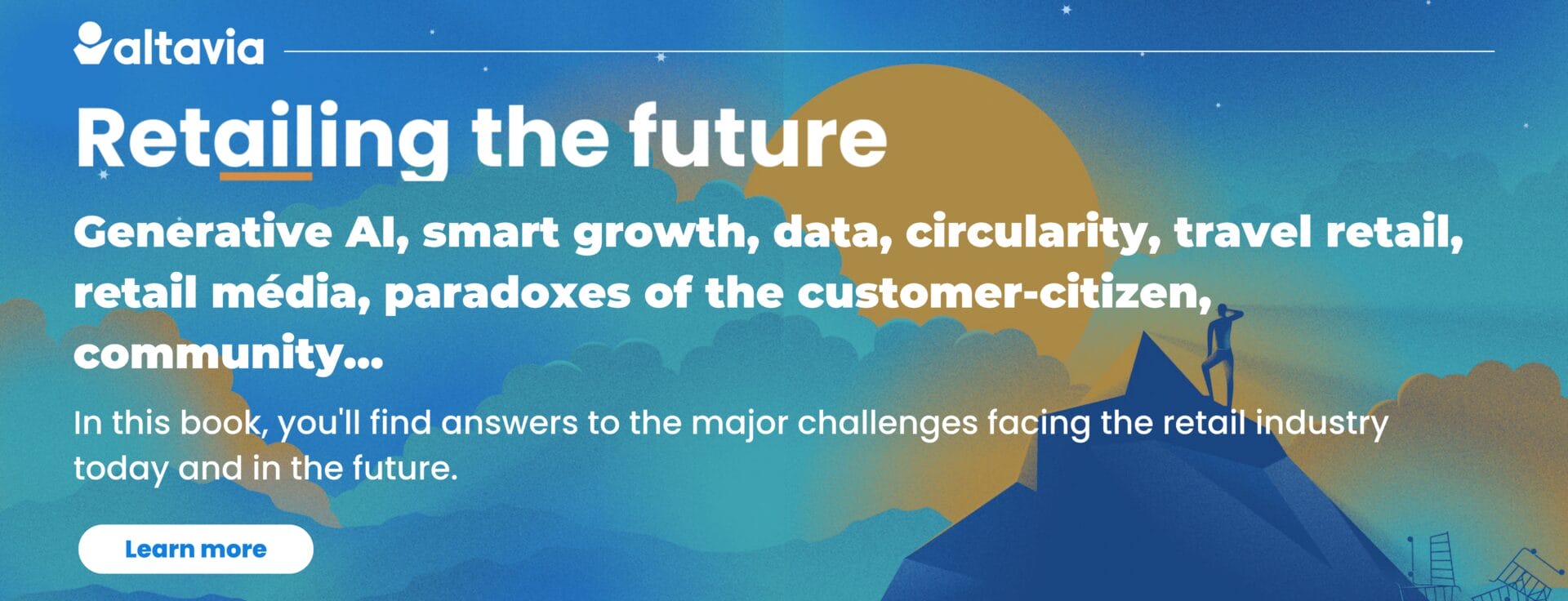Navigating italian retail’s dynamic landscape: Insights from Anna Casani, CEO of Altavia Italia.

Anna Casani, CEO of Altavia Italia, brings a dynamic perspective to the ever-evolving retail sector. Since taking the helm in June 2023, she has focused on guiding the agency through significant changes, enhancing service offerings for sectors ranging from Grocery to Automotive. Casani’s career journey—from the cosmetics industry to key marketing roles and now leadership—reflects her deep understanding of the retail landscape’s complexities. She emphasizes the importance of strong relationships and strategic innovation in driving client success and adapting to market shifts. Join us as she shares her insights on steering Altavia Italia forward in a rapidly changing environment.
Firstly, could you introduce yourself? Tell us about your background, your agency, its activities, and its clients.
I’m Anna Casani and I have been the CEO of Altavia Italia since June 2023.
Serving as the CEO of Altavia Italia is a privilege for many reasons, especially because it gives me the opportunity to dive into the retail field, which is an industry that nourishs my need for continuous challenges, growth, and improvement. Why? Because retail is one of the most dynamic sectors within the consumer industry landscape, it’s the heart of commerce and human transactions, it’s about humanity and entrepreneurship and it constantly evolves given the plurality of trends and challenges it has to face, and so am I.
What I particularly enjoy about our agency job is the relational dimension and the mission of accompanying our stakeholders. Supporting our clients to let them achieve their business goals is an exciting challenge, which brings dynamism, energy, curiosity and lateral thinking in our everyday business life.
I started my career in the cosmetic industry working in the marketing department of a hairstyle product company. I then moved to the USA to join the marketing department of Société Générale Group and in 2011 I moved to its headquarter in Paris.
In 2015 I joined Altavia Italia where I had the opportunity to change different key roles and get to know the exciting world around a communication agency and the retail market.
As a newly appointed CEO, my mission is to guide Altavia Italia through a very challenging phase of its journey. A new organization alongside a new service offer proposition driven by the Group building the foundations for the Altavia Italia of the future.
The aim is to keep bringing our best knowledge in the retail commercial activation field, for our market’s top players operating in the different reference industries, among which Grocery, Specialized Retail, Pharma, Retail Real Estate, FMCG, Beauty, Automotive and other.
What makes the Business Unit you are in special?
We carry an important heritage from our long-standing presence in the italian market. Over the last 30 years we have acquired knowledge around several key touchpoints of the retail communication, building a full integrated service portfolio starting from the strategic and creative concept landing to its execution and roll-out within the store, whether it is digital or physical. This is our DNA and competitive advantage in the market, and few other agencies can offer such a wide asset portfolio.
Today, we must adapt to a rapidly changing context, where technology, sustainability and consumer needs require retailers to re-shape their strategies in a very uncertain market environment. Therefore, we have to improve our go to market strategy, evolve our competencies and keep raising the bar. To do so, we can count on two fundamental assets which lead our transformation program and make us unique. First, our Group network which is our north star and gives us strength, solidity and a unique mix of competences, professional background and personalities. Having the chance to benchmark myself with other countries and markets brings diversity to our point of view, and makes us anticipate and translate the retail’s hot topics.
Second, our human capital. Our culture is based on professionalism and enthusiasm and our mantra is to always question ourselves to see the many possibilities ahead of us. As it is, our office is unique as well. A place where people can freely express themselves and their creativity and where clients enjoy coming. My experience speaks for itself. While building my professional growth in Altavia I had the opportunity to fulfill my biggest goal, a family of two kids that I can raise matching my ambitions for Altavia Italia. A healthy work-life balance is indeed something we pursue on an everyday basis for each coworker.
Which retail sectors are the most dynamic in your area?
Grocery, sportswear, home furnishing and pure players appear to be the most dynamic Italian retail sectors in 2024 (Istat 2024). The growth of grocery is driven by the demand for quality and sustainable products, while personalization is e-tailers’ share in the market. Sportswear and home sectors’ performances are linked to a strong interest in wellness and care for home spaces traceable as a post-pandemic consolidated trend.
What are the major consumer trends and developments in your country or region?
The dichotomy between online and offline has definitely collapsed when it comes to purchasing behaviors.
Italian consumers expect fluid and personalized shopping experiences in which online and offline can dialogue seamlessly. Moreover, consumers have gained concern and awareness around sustainability, and they expect retailers to make concrete steps within their supply chain ecosystem and raise attention on products’ quality (GS1 Italy, 2024). Indeed, an interesting trend that is growing especially across younger generations is the interest for second hand’s goods and rental (Cegid, 2024) as a part of the circular economy model. In 2023, 60% of Italian consumers chose to sell or buy used goods, and this data gives a sense of the scale of the phenomenon.
However, we have to keep our feet on the ground and highlight that price still plays a major role in influencing consumer choices. As a matter of fact, inflation led consumers to downsize transactions, paving the way for an increased growth of discounters and private labels. Despite some encouraging signals, the future still remains uncertain, so retailers will still rely on price for value based strategies (McKinsey, 2024).
How are new technologies, particularly AI, impacting the market you operate in?
Technologies and digital transformation are undoubtedly essential drivers for innovating retail. In 2023, digital investments regained a relevant position in retailers’ development plans. Investments aim to improve the experience inside the point of sale, guiding consumers, simplifying transactions and fostering in-depth products’ knowledge. Solutions such as smart payments systems, digital signage, digital kiosks, self-scanning solutions, and self check-out turn out to be the most adopted from a front-end point of view. However, today AI is the real hot topic that everyone is trying to address. Currently this is affecting the back-end operations, optimizing processes and productivity. But its potential goes far beyond that. By analyzing and systematizing massive amounts of data, GenAI could be the asset to create truly personalized one-to-one shopping experiences, having a concrete impact on the front-end. Anyway the market is just at the beginning of this journey, and we still have to understand how this potential could effectively be unlocked.
Could you provide a few examples or use cases that illustrate the major retail trends and innovations in your market?
Retailers are working hard to offer innovative and integrated in-store experiences which are built on a few key drivers: fusion of physical and digital shopping experience (omnichanneling), immersive and integrated technologies, relationship and emotion (National Retail Federation, 2024). Technological innovations are a driver, but not the only one.
Community, relationship, human interaction, emotion are other fundamental assets in order to provide truly distinctive and unique experiences.
An interesting example about how technology and the human factor can be combined and balanced in an innovative shopping experience is definitely the new Bershka flagship store in Milan. The store which aims to attract targets of digital natives is a unique shopping destination both in terms of service and products.
The store offers the choice between different kinds of experiences: a strongly integrated (offline-online) shopping experience focused on efficiency and speed (automatic click & collect area, automated checkouts on each floor, digital fitting rooms), and a slower shopping experience realized through engaging services and activities. How? Through a touch screen it is possible to book for 30 minutes a fitting lounge with lights and music (a wide dressing room) where groups of maximum four people can enjoy themselves trying on dresses and outfits with the assistance of dedicated staff. Outfits can be “augmented” by the filters that customers can download through the QR code in the dressing room and can be shared on social media. The fitting lounge is fully hi-tech, it recognizes garments which are inside it and, by a screen, suggests possible outfits and matching. Items can be purchased directly in this fitting lounge.
How do you envisage retail evolving over the next 10 years?
Honestly, to say what retail will be like in ten years from now is not an easy guess. Market, consumer behaviors and technological progress take different directions in such a short span of time that building up a so far future prevision can only be a risky gamble. In a social and economic context where the quality of the relationship between consumers and brands/retailers is linked to “experience”, the point of sale will continue to be an essential asset. In the coming years brands and retailers will be asked to be active players within the social and economic ecosystem in which they operate. They will have to be activists. The sharp criticism of consumers and their concerns about the future and the challenges that contemporary society has to face, emphasize the fact that retailers will be asked to take a position and undertake concrete actions maintaining consistency between statements and actions. ESG commitment is meant to become a congenital element of every business, which is not secondary.
On the side of technological innovation, for the next few years, we’ll run AI but, beyond awareness of its current impact, evolutionary scenarios are really unpredictable.
Instead, the thing we are certain about is that an essential key to success in commerce will be the strength of the bonds that brands and retailers will be able to build with their customers and their ability to reinvent themselves.
The human element will become a core part of retailers’ business strategies and a critical axis for differentiating them, their offers, their products.


